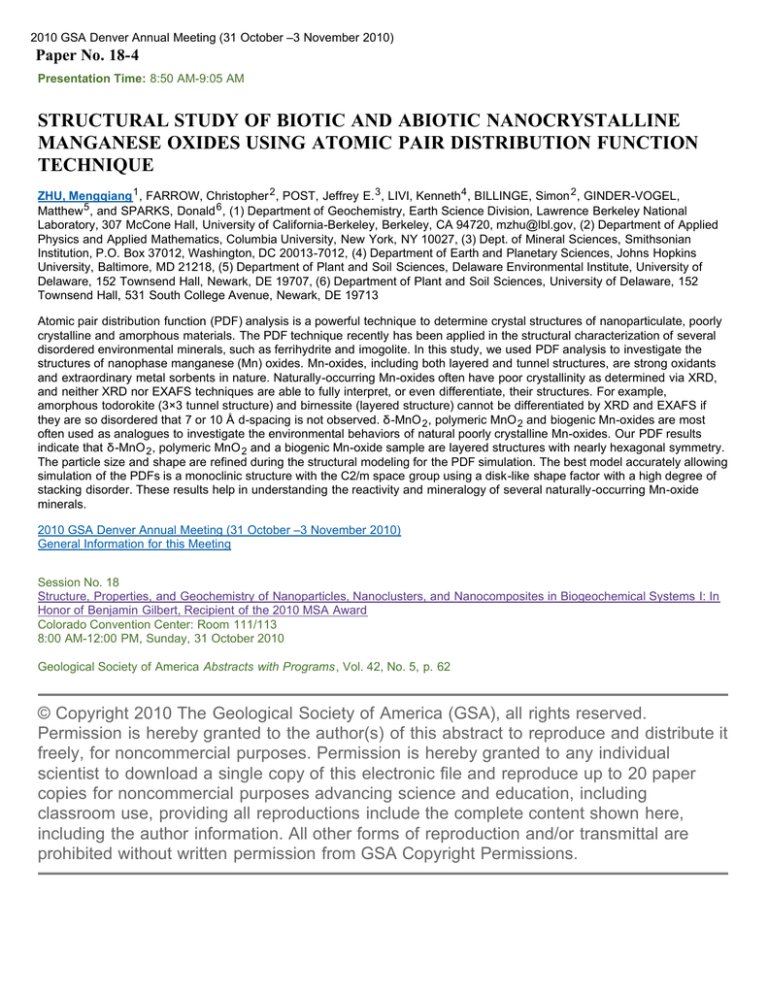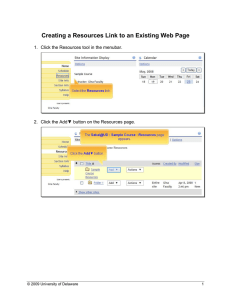
2010 GSA Denver Annual Meeting (31 October –3 November 2010)
Paper No. 18-4
Presentation Time: 8:50 AM-9:05 AM
STRUCTURAL STUDY OF BIOTIC AND ABIOTIC NANOCRYSTALLINE
MANGANESE OXIDES USING ATOMIC PAIR DISTRIBUTION FUNCTION
TECHNIQUE
ZHU, Mengqiang 1 , FARROW, Christopher 2 , POST, Jeffrey E. 3 , LIVI, Kenneth4 , BILLINGE, Simon 2 , GINDER-VOGEL,
Matthew 5 , and SPARKS, Donald 6 , (1) Department of Geochemistry, Earth Science Division, Lawrence Berkeley National
Laboratory, 307 McCone Hall, University of California-Berkeley, Berkeley, CA 94720, mzhu@lbl.gov, (2) Department of Applied
Physics and Applied Mathematics, Columbia University, New York, NY 10027, (3) Dept. of Mineral Sciences, Smithsonian
Institution, P.O. Box 37012, Washington, DC 20013-7012, (4) Department of Earth and Planetary Sciences, Johns Hopkins
University, Baltimore, MD 21218, (5) Department of Plant and Soil Sciences, Delaware Environmental Institute, University of
Delaware, 152 Townsend Hall, Newark, DE 19707, (6) Department of Plant and Soil Sciences, University of Delaware, 152
Townsend Hall, 531 South College Avenue, Newark, DE 19713
Atomic pair distribution function (PDF) analysis is a powerful technique to determine crystal structures of nanoparticulate, poorly
crystalline and amorphous materials. The PDF technique recently has been applied in the structural characterization of several
disordered environmental minerals, such as ferrihydrite and imogolite. In this study, we used PDF analysis to investigate the
structures of nanophase manganese (Mn) oxides. Mn-oxides, including both layered and tunnel structures, are strong oxidants
and extraordinary metal sorbents in nature. Naturally-occurring Mn-oxides often have poor crystallinity as determined via XRD,
and neither XRD nor EXAFS techniques are able to fully interpret, or even differentiate, their structures. For example,
amorphous todorokite (3×3 tunnel structure) and birnessite (layered structure) cannot be differentiated by XRD and EXAFS if
they are so disordered that 7 or 10 Å d-spacing is not observed. δ-MnO 2 , polymeric MnO 2 and biogenic Mn-oxides are most
often used as analogues to investigate the environmental behaviors of natural poorly crystalline Mn-oxides. Our PDF results
indicate that δ-MnO 2 , polymeric MnO 2 and a biogenic Mn-oxide sample are layered structures with nearly hexagonal symmetry.
The particle size and shape are refined during the structural modeling for the PDF simulation. The best model accurately allowing
simulation of the PDFs is a monoclinic structure with the C2/m space group using a disk-like shape factor with a high degree of
stacking disorder. These results help in understanding the reactivity and mineralogy of several naturally-occurring Mn-oxide
minerals.
2010 GSA Denver Annual Meeting (31 October –3 November 2010)
General Information for this Meeting
Session No. 18
Structure, Properties, and Geochemistry of Nanoparticles, Nanoclusters, and Nanocomposites in Biogeochemical Systems I: In
Honor of Benjamin Gilbert, Recipient of the 2010 MSA Award
Colorado Convention Center: Room 111/113
8:00 AM-12:00 PM, Sunday, 31 October 2010
Geological Society of America Abstracts with Programs, Vol. 42, No. 5, p. 62
© Copyright 2010 The Geological Society of America (GSA), all rights reserved.
Permission is hereby granted to the author(s) of this abstract to reproduce and distribute it
freely, for noncommercial purposes. Permission is hereby granted to any individual
scientist to download a single copy of this electronic file and reproduce up to 20 paper
copies for noncommercial purposes advancing science and education, including
classroom use, providing all reproductions include the complete content shown here,
including the author information. All other forms of reproduction and/or transmittal are
prohibited without written permission from GSA Copyright Permissions.






![O3-type Na(Mn[subscript 0.25]Fe[subscript 0.25]Co[subscript 0.25]Ni[subscript 0.25])O[subscript 2]: A](http://s2.studylib.net/store/data/011566198_1-f59231d92b063d96bf5d9296194842f7-300x300.png)